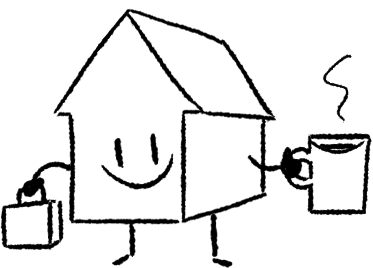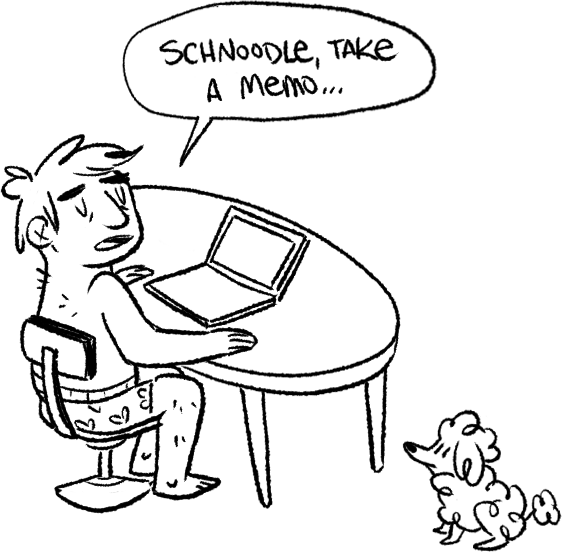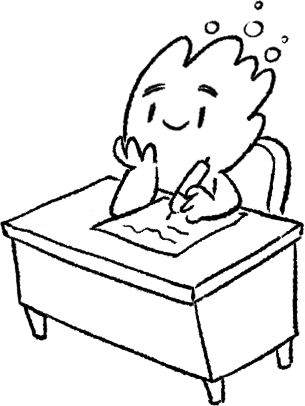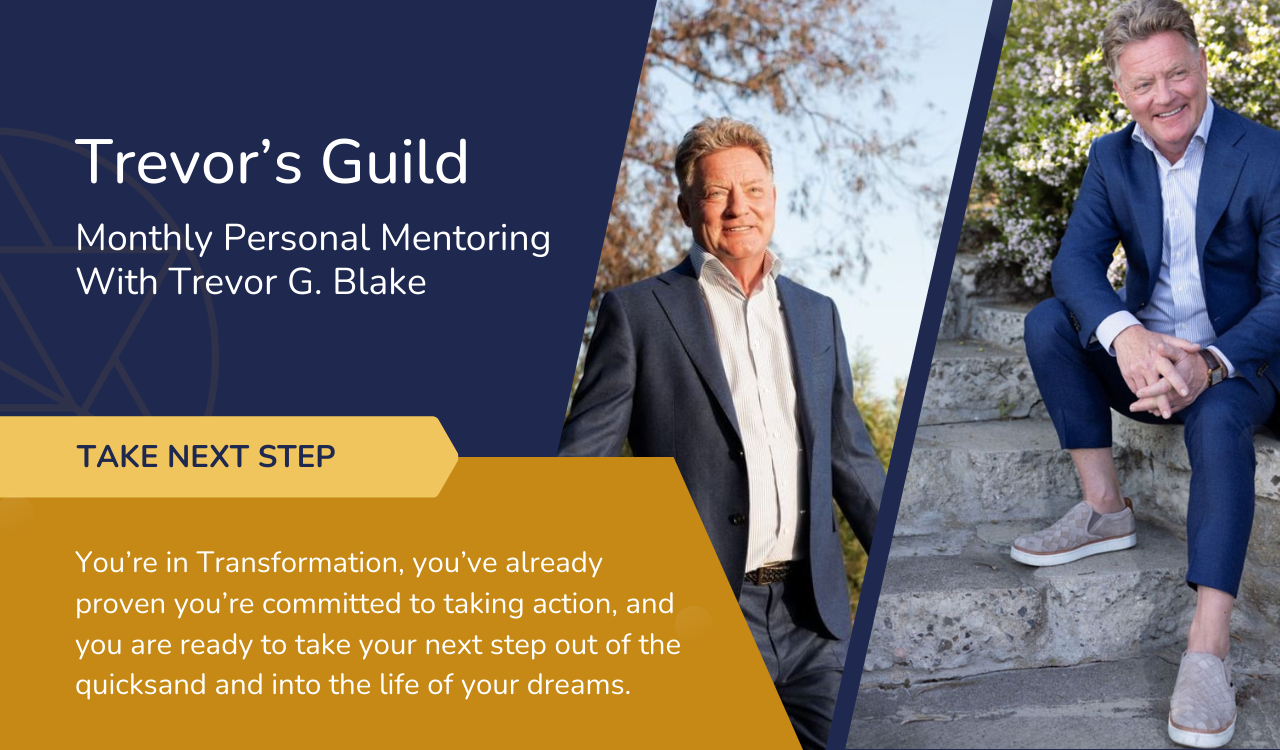Reacting Forward (3): Transition to A Home Office
“There’s just not that many videos I want to watch.” – Steve Chen, 2005
(CTO and co-founder of YouTube expressing concerns about his company’s long term viability)
If possible, start your startup at home.
Many new entrepreneurs seem eager to lease office space for their new business. Typical, their first purchase is a large sign of the company name to display over the entrance. Appropriate if your business is a retail store visited by paying customers, but unnecessary for most startups using the hub model.
Especially since the owner is the only employee. Even if your company is a quasi-hub, with one or two employees, I recommend having everyone work from home until the business becomes established. Office facilities are not cheap. As well as the cost to rent, there usually is a minimum rental period of six months or more. As well as rental cost, here are additional fees to consider with office space:
- Security
- Utilities
- Repairs
- Customizing signage and configuration to your company
- Receptionist
- Business property tax
- Heating, ventilating, air-conditioning
- Furniture and equipment
- Office supplies
- Janitorial services
- Maintenance and repairs
In addition to lower overhead costs working from home, you also might be entitled to certain tax deductions for the portion of your home that you work from. As with hiring too soon, leasing an office before you need one uses vital capital and impacts cash flow.
Ask yourself, honestly:
Do you want an office as an ego boost, or is it genuinely essential?
What will you do in your office that you can’t do from home?

In the early months and years of a company, cash flow is so critical to survival that it makes sense to consider alternative setups. Current and emerging technology makes it easy to manage a business and be productive from home.
Whenever people hear, ‘home-based office,’ they often imagine small, part-time endeavors with a desk shoved in the corner of a living room or basement. This is completely different from running a home office as an owner. If you’ve only worked in an office for large, structured companies that provide systems, administrative support and facility management; the transition can feel big. However, using the tips below, you can shift successfully and might even find it surprisingly fulfilling.
Working from home started to emerged in the early 2000s. Telecommuting technologies kicked off and workers could avoid commuting, enjoy flexible schedules, and achieve a better work-life balance.
Then, during the COVID-19 pandemic, many workers were advised to work full time from home. This redefined the conventional concept of working from home that was typical only for certain types of work.
The Transition
The transition to a home office can be challenging for those who are used to a traditional one or those who have been a homemaker for any length of time. Thinking of home in the same professional manner as an office takes some adjustment.
This was never more apparent than during the lockdowns associated with the 2020 pandemic. This time period had far-reaching implications for most as they adjusted to lockdowns and mandatory working from home. In most cases there was no training and limited support provided.
There is no doubt lockdown accelerated the adoption of remote working. In 2019, the Office for National Statistics (ONS) found that while over 30% had the opportunity to work remotely in 2019, less than 6% did so on an ongoing basis. During lockdown, this grew to over 48% according to the ONS.1 A similar survey by the Chartered Institute for Personnel & Development (CIPD) found 61% of respondents working remotely (Houghton, 2020).

With minimal to zero support provided to help people in the sudden transition, it’s no surprise there were many issues.
For individuals who lived alone, working from home without face-to-face interactions and social support contributed to mental health issues such as social isolation and depression.
For others, blurred work-life boundaries made it difficult to mentally detach from work, increasing stress, anxiety and impacting family experiences.
Effective home offices and routines grow out of the same kind of insights that great companies [JC1] [tb2] do. They begin with people who are able identify their own needs, both as workers and as business owners. It’s important not to assume it will be an easy transition. Prepare with the same attention to detail with which you create your business plan or manage cash flow.
Choose a suitable space in the home that will be your workplace. Then, assess your business technology needs separately from the rest of your home. The early months of a new business are hectic, the more efficiency and automation you can build into the setup before you start, the smoother it will be for you. Also, know and manage yourself in ways that help you develop a productive routine.
Create a Separate, Defined Office Space
An office space that is separate from the main living space, and family traffic, is preferred. A spare bedroom was my first such space. Then, I had a bonus room converted to an office. Eventually, I enjoyed a separate casita.
This creates a physical boundary between work and home, which helps us mentally transition when we “got to work” in the morning and “return home” at night. It also helps family and house-guests to acknowledge and respect that work boundary.
Sometimes, a home or apartment won’t have an obvious dedicated workspace, so, you must thoughtfully create one. In a separate office space, background noises are less disturbing, also, if your family and children can’t see you, the temptation to interrupt you goes away. Over time, your mind will adjust whenever you enter and leave your office space. This will help you stay disciplined when you’re at work and help you relax in other parts of the home when you’re not working.
Although it sounds obvious, a door that closes off your office space is essential.
Even if outside noise is limited, shutting the door is necessary. It aids concentration, avoids distractions, and provides a more professional environment.
Many times I’ve called a potential consultant and heard dogs barking or children playing in the background. This does not give a professional impression.

If possible, I highly recommend making sure your office space has a window that gets natural daylight. Working out of a basement without a view is even more depressing than the neon-lit cubicles in most workplaces. There are lots of health benefits to having natural daylight pour in, also, it helps alleviate any sense of isolation from the world.
Use Dedicated Technology for Business
The office space and the business you run should have dedicated computers, printers, and communication devices. So many people have one device that is used for both business and pleasure. That means constant distractions during the workday and constant business intrusions during relaxation times. A balanced life requires discipline and separation. Your computer and communications devices must not be shared or accessible to others in your family. This way no one in the house can interrupt your productivity or accidentally answer your business calls. So much can be accomplished with a mobile device, but it’s a mistake to think that the mobility of a device makes you productive just because you can work from anywhere. There is also nothing more annoying as a customer than when the businessperson you are speaking to gets interrupted by a personal call. One device must be dedicated only to work.
For instance, if someone uses the same smartphone for business, family, news, and gaming, the temptation for distraction is too great. Checking a text, reading a news alert or playing, “just one game.” Taking breaks is a good thing, but I suggest doing so by leaving the office and using an alternative device. Having separate devices may seem like an unnecessary expense at first, but it’s critical to separate business and home to achieve a balanced life.
As a rule of thumb, I have a smartphone, laptop, landline, tablet, and printer dedicated to my businesses. They are used for no other purpose. I never give my business email or telephone numbers to non-business-people or my domestic contact details to those I do business with. Most entrepreneurs I know use one device to handle business and pleasure, their lives become chaotic and unproductive without realizing why. Since most of your meetings will be video links, it’s important to also invest in a professional microphone and camera that works well with your laptop or device. When you host those sessions, the background behind you should be one that does not distract anyone. A plain wall suffices.
Set unbreakable routines
Humans need routines and there are many studies that show the mental benefits of routines. Working from home as an employee, and running a business as an owner from home are completely different things. In the former you work for a structured company, albeit remotely, with its various levels of system and human support available via phone or computer. In the latter, you work for yourself and your support comes from, well, you. Entrepreneurs who get it wrong and don’t set a routine they can live and work with, don’t stay in business long.

Most entrepreneurs underestimate how productive they can be without all the traditional office distractions, and start out working long hours. It soon becomes stressful and they find themselves sitting in front of the phone waiting for it to ring or staring at the computer screen willing an email to pop in. That’s why regular breaks and setting do-not-disturb start and finish times are beneficial.
In the many biographies I studied, I became fascinated by the routines and schedules of the hero. Most of them didn’t seem to work much at all. Two of my favorites were C.S. Lewis and Winston Churchill.
C.S. Lewis relied on a steadfast daily routine as he worked from home on his writing projects and business affairs.
“I would choose always to breakfast at exactly eight and to be at my desk by nine, there to read or write till one. If a cup of good tea or coffee could be brought me about eleven, so much the better. A step or so out of doors for a pint of beer would not do quite so well; for a man does not want to drink alone and if you meet a friend in the taproom, the break is likely to be extended beyond its ten minutes. At one precisely, lunch should be on the table; and by two at the latest I would be on the road. Not, except at rare intervals, with a friend. Walking and talking are two very great pleasures, but it is a mistake to combine them. Our own noise blots out the sounds and silences of the outdoor world; and talking leads almost inevitably to smoking, and then farewell to nature as far as one of our senses is concerned. The return from the walk, and the arrival of tea, should be exactly coincident, and not later than a quarter past four. Tea should be taken in solitude. For eating and reading are two pleasures that combine admirably. At five a man should be at work again, and at it till seven. Then, at the evening meal and after, comes the time for talk, or, failing that, for lighter reading; and unless you are making a night of it with your cronies there is no reason why you should ever be in bed later than eleven.”
What a relaxing, inspiring routine that all sounds.
No two routines would be alike. Perhaps you would also like to consider the quite remarkable daily schedule observed by Winston Churchill?
According to The Churchill Center and Museum at The Churchill War Rooms, Chartwell Manor, London, in the 1930’s, when Churchill was a prolific writer, he awoke at 7:30 a.m. on the dot. He insisted on a regimented routine and organized his staff to abide by it. He remained in bed for a substantial breakfast and reading of mail and all the national newspapers. For the next two hours, precisely, and still in bed, he worked, dictating to his secretaries.
At 11:00 a.m., he arose, bathed, and took a walk around the garden. Then he took a weak whisky and soda to his study where he worked on his books for two hours.
At 1:00 p.m. he joined guests and family for a three-course lunch. Clementine drank claret, Winston champagne; preferably Pol Roger served at a specific temperature, port brandy and cigars. When lunch ended, about 3:30 p.m., he returned to his study to work.
At 5:00 p.m., after another weak whiskey and soda, he went to bed for an hour and a half. He said this siesta, a habit gained in Cuba, allowed him to work 1 1/2 days in every 24 hours. At 6:30 p.m. he awoke, bathed again, and dressed for dinner at 8:00 p.m. After his guests retired, Churchill returned to his study for another hour of work.
I doubt that my liver could tolerate that Churchill regimen, but it is fun to read nonetheless. What strikes me most about those routines are the balances between work and leisure.
When you work in a regular office, you typically have a routine that’s almost on automatic pilot. You know what time you need to wake up, what time you need to leave the house, when your first meeting’s scheduled, when it’s acceptable to take lunch, etc. When you transition to home, you need to set a new routine, one you can easily stick to.
Now, I’d be a hypocrite if I said I follow routines like a robot. A start-up is a world of surprises and that is one of the pleasures. No two days are the same. The downside, at times running a start-up can feel like running around putting out fires. It can be stressful. So, we must in build relaxation breaks that allow us to take a breather, lower stress, and feel mentally strong.
Despite their unique routines, CS Lewis and Churchill had a balance to their typical day. They took walks with fresh air, enjoyed the arts, ate and drank, all set in routine around their core activity.

When you transition to home you need to set a schedule with devoted vigor. Here is my typical entrepreneur schedule. It’s served me well, I suggest you do likewise at least until you feel confident and successful enough to make changes without jeopardizing that. I will add notes and intimate detail… no not that intimate… so you can see the method to my madness. Writing it down might make it seem obsessive, but it’s done for a reason and with a smile. Critical to setting up each day is an unbreakable morning routine.
6:30 AM – Wake up (no need for alarm as this has been my wake up time for decades. Also, I find alarms well, alarming, not a positive way to start the day). I jump out of bed without hesitation. I make myself smile no matter how sleepy I still feel. I stretch. Note, there are no phones or computers in the bedroom as the temptation to check email or voice-mail is too great. They are locked away in my office. TV or radio stay in the off position. Once you switch on and allow all that negative junk in your head, you might as well quit for the day.
As I shower and get dressed, I quietly speak several affirmations to myself. I make them up daily, for example: “Good morning life. I feel fantastic today and I know we will do some great things together. I am Trevor G Blake and I am… then I reel off my current Intentions and play my mini-mind movie (see The Transformation Experience), which take about a minute. Everything I do is simply what I’ve observed in dozens of biographies of successful men and women throughout history.
Dress in comfortable clothes fitting for the role of CEO. Smart casual is fine, but don’t fall for the, ‘it’s okay to dress in sweatpants when I work from home.’ It’s not.
Next, go to private room to Meditate (Take Quiet Time. see Transformation)
This is followed by activities such as walks that connect me through nature.
Then followed by a leisurely breakfast.
No TV, no checking anything online, no radio = No fearful headlines = balanced energy = peak brain
Note, I have deliberately stopped myself checking anything work related. I have not checked email, texts or voicemail. I have no social media, my online marketing vendor takes care of that.
This is not easy, but getting into this habit early on in your business will help with the stress load. We must build balance and avoid the temptation to simply wake up and check messages or wake up and go into the home office.
9:00 AM on the dot – Into my office, the very first thing I do is to read my white board (see later activity) and do whatever item I placed as priority 1 the evening before. This is essential discipline. Note, I still haven’t checked messages even though I know there are many waiting from several different time zones. This takes discipline, but science shows it takes 34 minutes to get back on track every time we are distracted by a ping.
11:00 AM – No matter how busy I am, I take a break. No matter the weather, I get outside and do not return to my office until 2 pm. I leave at 4 pm. Door is locked. Devices inside. Sometimes, I like to write between 5 and 6 pm which is when the brain is most tired, the perfect situation for creative thinking.
A real life example always helps:
Getting it virtually wrong
My friend Phil had recently lost his job as CEO. His style of management was to surround himself with a mastermind group of highly paid Vice Presidents with massive egos. Hence he filled his days with an endless round of meetings.
Phil was a hard worker; in the office before anyone else, and last to leave. I never saw him take a day off. He was fair-minded, highly intelligent, and the staff liked him, but he struggled to make the difficult decisions himself. He relied so heavily on the abilities and recommendations of his mastermind group that he became blind to the fact that they fed him only what they thought he wanted to hear and what made them look good in his eyes.
Getting the boot hit him hard, and he decided to leave the corporate world he had known for thirty years to start his own consultancy company. After years of stressful commuting on congested freeways, he told me how much he was looking forward to the freedom of working his business from home as well as being away from office politics.
Phil spent all his working life in a traditional office environment. His routine was to try to beat the rush-hour traffic by getting to the building before 8 a.m. and not leaving until after 6 p.m. for the same reason. His day was planned out by his personal assistant and consisted of meetings with department heads and phone conferences with his board of directors and advisers. Twice a day he walked through the office, making sure to speak with as many of his staff as possible. He usually skipped lunch, but every Friday he allowed the staff to dress casually while he held a lunchtime staff meeting. His office door was always open, and he encouraged people to stop in for a chat. As commendable as that is, most employees are intimidated by the CEO title, so his frequent visitors were the senior managers.
Any habit, especially one formed over thirty years, is hard for us to change. The brain is hardwired to repeat certain traits and behaviors. To suddenly go from a busy and traditional schedule of human interaction to the isolation of working from home is as big an adjustment as transitioning to civilian life after military service, or jumping into the working world after college. I had tried to warn Phil not to underestimate the difficulty of the transition, that it can take months to adjust, and that it requires great discipline to develop productive new habits while working from home. Most people assume that it is an easy thing to do, and from his body language, I could tell Phil was ignoring my advice.
Several months later, Phil confessed to me that he was finding the change very hard, and in fact so difficult that he was considering quitting his business and returning to a regular work environment. I visited him at his apartment, a splendid penthouse with panoramic views of the ocean. Floor-to-ceiling windows allowed sunlight to fill every space. As majestic as the view was, it would be hard not to be distracted by the waterfront activity below.
Phil’s apartment was contemporary and minimalistic. I asked him to show me his office space. With a sweep of his hand, he gestured around the apartment.
Phil had made all the classic errors I had warned him to avoid. He confessed that he sometimes lay in bed later than he should, and on those days he would simply stay in his pajamas, set up his laptop on the kitchen table and start work. Oftentimes he did not shower or shave until midday. It is so tempting to check email first thing after rising, and before you know it half the day has gone and you are still in your pajamas. He had constant access to the refrigerator, and there were used dishes everywhere that explained his extra pounds since he stopped commuting to an office.
He said loneliness was the hardest thing to adjust to. As a CEO in the traditional setting people sought him out, and his office was always busy. He had an assistant to manage his calendar, and bring him coffee. They always chatted about personal matters as much as business. He knew their families and had met many of them. He had prided himself on having an “open-door” policy at work, and although he was a humble man all of that pilgrimage to his office subtly boosted his ego. Employees rarely speak out of turn to the CEO, and most leaders only hear positive things about themselves and the company they run. He had the same blind spots as any other CEO.
Without that frequent reassurance of his leadership role, he admitted to feeling depressed at times. His energy levels were low and he thought he might have developed an endocrine issue of some sort. The effects were showing up in his business, because he found it difficult to muster up the necessary enthusiasm in his voice when speaking with potential clients, and he sometimes did not have even the motivation to call people back when they left a message. As I listened to him confess, I realized he was showing early symptoms of depression brought on by what amounted to self-enforced solitary confinement.
For the first few weeks, he said some of his ex-colleagues had called him to see how he was doing with the new company venture, but eventually those calls fizzled out. To alleviate the seclusion, he started calling them to check how the old company was doing in his absence. It was like a retired coach who can’t stay away from the training ground. Before long, he sensed that his ex-colleagues were ignoring his calls whenever they saw his number on the display.
Phil said he liked the sense of freedom from routine, and that sometimes he exercised in the mornings and caught up with work later at night. At other times he put the TV on in the background, and liked the fact he could check on his stock trades while working.
Phil had committed every home office crime in the book. He needed rehabilitation, and I started it by getting him to promise that with everything he did, with every detail of his daily schedule, he would ask himself out loud “would this be appropriate behavior in the traditional office?” In other words, if it were inappropriate in his old way of life, why would it be acceptable now?
I asked him to think about what would have happened when he was CEO if he sometimes lay in bed, or turned up to work in his slippers and pajamas? How productive would he have been if he set up his laptop in the company cafeteria?
Working from home requires not just the same discipline as going to a regular job, but much more. The source of motivation used to be a pay-check and a need to be seen as a good performer by bosses and peers. Now the source is just you. Not everybody has a high degree of self-discipline, and Paul’s lack of it surprised me. Such a strong and forceful personality in the regular office, I had not expected him to trip up so easily at home.
Humans seem to need routines, and breaking them can lead to stress and depression. We need rules, regulations, and schedules at home as much, if not more so, than in a work environment. Otherwise, running a virtual business will quickly cease to inspire us, and we will become like a hopeless addict, procrastinating and grabbing any distraction, as we go back to the fridge or the TV when we should be working.
It is by no means easy and one has to be a obsessive about it. I can recall falling out with family and friends who were visiting us from the UK. They all worked in traditional offices and found it hard to accept that I could work from home. When I refused to change my schedule to join them for lunch or hang out in the back yard they thought I was just being pedantic, or that I was sending them a ‘not welcome here’ message. Thick skin and hard headed attitude are needed.
Getting it Virtually Right
Effective home offices and their routines grow out of the same kind of insight that great companies do. They begin with people who can identify their own needs both as workers and as business owners. It is important not to assume that it will be an easy transition. You should prepare for it with the same attention to detail with which you would prepare for new career paths or job relocations. You need to choose a suitable space and assess your technology needs beforehand so that your new home office is compatible with your needs when you are ready to begin. The early months of a new business are hectic and the more efficiency you can build into the set up before you start the better. Space in a home can be limited, but there are certain “must haves” that make developing a productive routine easier.
I did not meet up with Phil again for a couple of years, and I had forgotten the rehabilitation process we went through. The first thing he said when we met again and shook hands was to thank me. He said, “You made me set up a separate office within the apartment. I thought it was a waste of a beautiful space at first, but it is the best thing I ever did. Closing that door and having a separate place to work saved me. It still took me months to adjust to working from home, but without that, I doubt I would have made it.”
I asked Phil to describe his adjustment period:
How difficult was the change?
“After 20 years of going to work outside my home, the transition to working at home was difficult, but manageable. It was stressful at first, because I had to set up a home office including updating my computer, learning to back up files, getting a copier / scanner / printer, upgrading my Internet to faster service, setting up a fax number, getting business cards, setting up an accounting system, etc. etc. etc. It sounds simple, but all this took some time, and some of the tasks were things my personal assistant and staff used to do for me. I felt pretty dumb at the time, like a remedial student. It was humbling.
The hardest single technical aspect of setting up the home business was the lack of IT support. In all my previous positions, I simply picked up the phone when I had any issue or question and an IT expert was there to help. In my home office, I had to wade through my technical computer issues by myself. I tried calling a local IT support company a few times, but they were expensive and seemed to spend a lot of time researching my question instead of already having the required knowledge. Consequently, I spent a lot of time learning technical computer stuff. But now I am the neighborhood expert.”
How long did it take you to adjust?
“It took me about 6 months to adjust to working at home. I needed to get a routine going and had a couple of false starts with that. After you weaned me off daytime stock market TV, I started over. Initially, I thought I should keep it like a regular job. Start at 8 am, work until 12, take an hour lunch, and then work until 5. But that is way too intense at a home office. Remember, there are no meetings to attend, nobody stopping by your desk to chat, no chatting in the break room, etc. An 8-hour workday at home is more productive than spending 16 hours at the old office. Burn out is a real risk.
What ended up working best for me was to break up my day. Work for a few hours early in the morning, then go to the gym, come back, and work for a few more hours, then take another break like a walk or errand, then come back and finish up whatever work was needed that day. This schedule made the workday longer, but I found I was less tired and stressed at the end of it.”
What was the thing you enjoyed most in your new workday?
“The thing I enjoyed most about the new workday was my new found flexibility. If I had a personal appointment that day, I could simply start earlier in the morning or work later in the evening. To take a break from the computer and phone I could go shopping during the week when things are less crowded or rushed. It is amazing how much more pleasant grocery shopping is in the middle of a weekday, than facing the high stress after 5 or weekend frenzy. In the winter, I could actually take a walk during daylight hours! A neighbor below me works nine to five and her dog is cooped up all day, so I started taking it for a short afternoon walk, which was good for everyone.”
What did you miss the most about a regular office environment?
“Without a doubt, the thing I missed most was the day to day people contact and the relationships with other workers. I still miss the friends I made while working and needed to find an alternative way to connect with people. Let’s face it, it is hard to have a good conversation with a dog!
I found other ways to interact with people. I joined an exercise group at the gym and got to know other work-at-home people. I talk to the neighbors, grocery clerks, and others more now because I have more time and I am not always feeling so rushed. I also joined the local small business owner’s society. They are great ways for executives to meet and share best practices, but just as important is the social interaction.”
Do you have any tips to help others make a successful adjustment?
“I think everyone needs to find out what works best for them and don’t be afraid to make changes if something is not working out. One of the best things about working at home is that your work hours are flexible. If you love to stay up to 2 am, then go ahead and use that time for work. The other thing is don’t take on too much work or play. You need a balance and it is really easy to stress yourself out by taking on more than you can handle. Most of all though, I realize I almost blew it by not starting off right. Knowing what I know now, I would have spent time getting the office set up before I started my own thing. I lost so much traction and productivity early on and only after six months was I back on track.”
I like what philosopher Alan Watts had to say on refusing to make a distinction between work and play.
Success with balance requires discipline to mix work and play in such a way that both simply become equally pleasurable. When we get it right working from home lends itself to success with balance.

Homework Time:
Many entrepreneurs will start a company from home without taking the time to consider the potential impact and disruption on family life.
This is the time to wander through your home and identify a separate space with a door to become your office. Whether you have your winning idea yet or not is irrelevant. This action is all part of the ‘reacting forward’ process.
In designating a room or area as your office space you are programming your R.A.S. to help you think and behave like a successful entrepreneur.
It also gets you in the habit or separating work and life.
There are lots of helpful videos and articles online to help you furnish and set up the perfect space for you. Doing so before you actually start a company sets the tone and culture within the family life.


